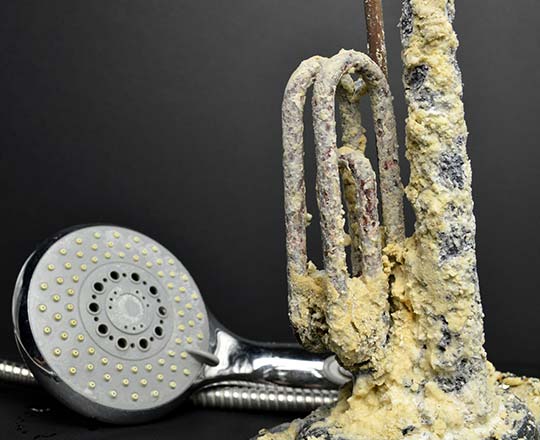Want fewer hard water stains and fewer hard water pains?
Nothing is better than our eco-friendly line of premium salt-free water softeners and conditioners.
Hard Water
Water consisting of calcium and magnesium creates hard water, and it is often supplied by a private well or a town. The majority of homes in Minnesota have hard water and do not realize they have it, causing corrosion and costly damages.
Many times, hard water-related problems are simply viewed as poor quality products and household appliances. Hard water can cause dry skin and hair, bathtub rings, spots on glass and silverware, dull clothing, disappointing performance, and a shortened life expectancy of water-using appliances. Many consumers don’t realize how much time, money, and energy are spent fighting the hard water battle every year.
Cloudy Water
Turbidity is murky, cloudy or grayish water usually caused by dissolved or suspended solids. The presence of sediment or transparent substances can trigger turbid water. It happens naturally or is provoked by various disturbances, including construction, storms, and urban runoff.
The turbidity of your water can range anywhere from low to high. Even if your water appears clear, it could still contain an excessive level of dissolved solids. We recommend you have your water analyzed if it is egregiously turbid, we will recommend appropriate treatment methods if needed.
Chlorinated Water
Chlorine has been used since the 1850s as a form of disinfectant to kill harmful bacteria in water itself or the pipes that transport it. It is a very valuable tool for stopping a number of dangerous threats to public health. Even though chlorine in water is vital at the water treatment facility and in the water distribution system, it is no longer necessary for the water you drink once it reaches you.
Chlorine is a vital part of inhibiting the spread of disease, but the benefits come at a price. It manifests itself through its bad taste and smell. Washing hair and skin with chlorinated water leaves them dry, while clothes fade as a result of exposure to this water. Rubber seals in home appliances and toilets dry out because of contact with the chlorine in water.
Tastes and Odors
Water is colorless, tasteless and odorless. Does your water taste or smell funny? If so, you owe it to yourself to find out why.
- Earthy or musty tastes and odors:
Although these tend to be more unpleasant than poison, generally a result of compounds released due to decayed vegetation and are typically associated with different forms of algae. These issues are extremely widespread in supplies that depend on surface water as their source. These sources are not necessarily toxic, but they are not pleasant in small quantities. - “Rotten egg” smell:
Another common source of smelly water is hydrogen sulfide. Hydrogen sulfide is a colorless corrosive gas that has the characteristic odor of rotten eggs. The odor is most commonly found in groundwater supplies and can be noticed coming from hot water tanks. Hydrogen sulfide gas can occur naturally from deep in the ground or can be produced by sulfate-reducing bacteria. - Metallic Taste:
A metallic taste to your water may be due to the presence of minerals such as iron, manganese, copper, or zinc. Iron and manganese are naturally found on earth, while copper and zinc may be derived from water that is already aged or the negative result of copper plumbing or brass fittings.
Water Staining
A natural solvent like water, when allowed the appropriate amount of time and conditions, can dissolve anything it’s in contact with. Depending on what region you live in, your water can be infused with iron or manganese, which can cause rust-colored-orange or black stains. You may even see changing your hair’s color. Or if your water has a low pH, you’ll see the telltale blue-green colors.
You’ll see the stains on clothes, fixtures, sinks, tubs, water-using appliances and toilets. The stains may be on anything the water comes in contact with. Removing the stains is quite tough, even if you are able to clean them at all.
Bacteria and Viruses
The Centers for Disease Control and Prevention reports there could be as many as 12 million cases of waterborne gastrointestinal illness annually in the United States alone. Bacteria, viruses, and protozoa can make their way into the water supply and cause illness. These contaminants can survive in the environment for months. Even well-operated, water treatment plants cannot ensure that drinking water is entirely free of microbial pathogens. System failures do occur, and not all systems are functioning at the levels they should.
Contact the experts at Chicago Water Pros today!
If you’re concerned about the safety of your water supply, contact us for a free water test and in-home plumbing audit. We will get you reliable facts you can act on with confidence, and give you dependable solutions if your water needs treatment.

